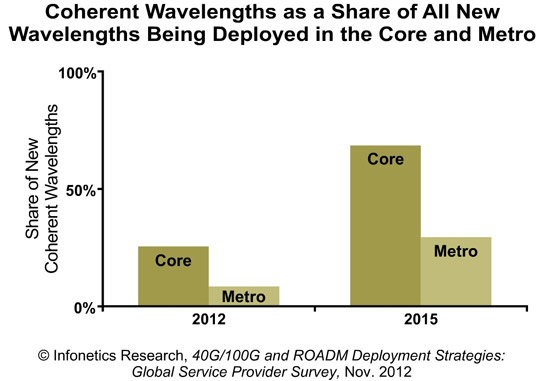- News
24 December 2012
Coherent 100G to take over core networks
Market research firm Infonetics Research released excerpts from its ‘40G/100G and ROADM Deployment Strategies: Global Service Provider Survey’, which details the plans of operators transitioning optical transmission and switching equipment to higher-speed 40G and 100G wavelengths.
“The debate between 40G and 100G in WDM [wavelength division multiplexing] networks is over, so for our latest 40G/100G and ROADM [reconfigurable optical add-drop multiplexer] deployment strategies survey we focused on identifying how the rollout of 100G will take place and to what degree networks will migrate to coherent technology and ROADMs,” explains Andrew Schmitt, principal analyst for optical at Infonetics.

Graphic: Among Infonetics' survey respondents, by 2015 coherent wavelengths will account for 68% of deployments in the core and 29% in the metro, and 100G will rise from just 5% of deployed wavelengths in 2012 to 37% in 2015. (Graphic: Infonetics Research)
“Operators participating in our study expect coherent 100G to take over most core networks by 2015 and even make some minor inroads into the metro.”
Highlights of the survey include the following:
- Among survey respondents, by 2015 coherent wavelengths will account for 68% of deployments in the core and 29% in the metro, while 100G will rise from just 5% of deployed wavelengths in 2012 to 37% in 2015.
- Carriers have mixed opinions on the future of various metro 100G approaches, including direct-detect 100G, pluggable coherent, and advanced modulations such as 16-QAM.
- ROADMs are now a major part of optical networks, with ROADM nodes and degree counts set to surge by a factor of more than two.


